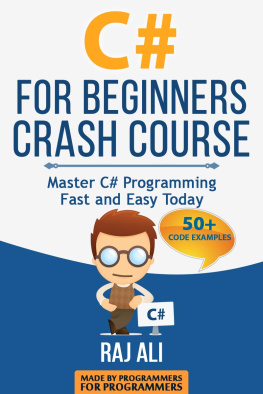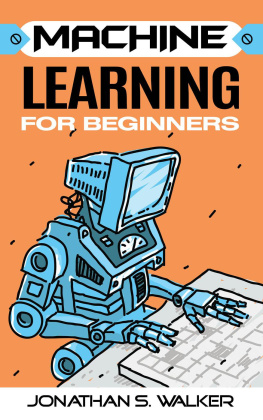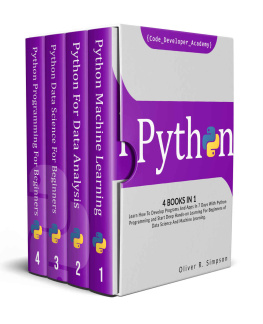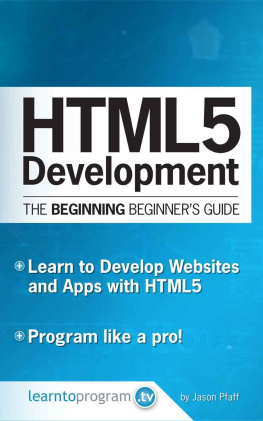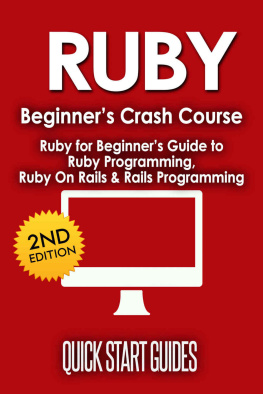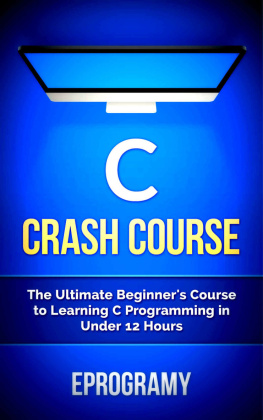C# For Beginners Crash Course
Here you can read online C# For Beginners Crash Course full text of the book (entire story) in english for free. Download pdf and epub, get meaning, cover and reviews about this ebook. year: 2015, publisher: PRX Publishings, genre: Computer. Description of the work, (preface) as well as reviews are available. Best literature library LitArk.com created for fans of good reading and offers a wide selection of genres:
Romance novel
Science fiction
Adventure
Detective
Science
History
Home and family
Prose
Art
Politics
Computer
Non-fiction
Religion
Business
Children
Humor
Choose a favorite category and find really read worthwhile books. Enjoy immersion in the world of imagination, feel the emotions of the characters or learn something new for yourself, make an fascinating discovery.
C# For Beginners Crash Course: summary, description and annotation
We offer to read an annotation, description, summary or preface (depends on what the author of the book "C# For Beginners Crash Course" wrote himself). If you haven't found the necessary information about the book — write in the comments, we will try to find it.
Unknown: author's other books
Who wrote C# For Beginners Crash Course? Find out the surname, the name of the author of the book and a list of all author's works by series.
C# For Beginners Crash Course — read online for free the complete book (whole text) full work
Below is the text of the book, divided by pages. System saving the place of the last page read, allows you to conveniently read the book "C# For Beginners Crash Course" online for free, without having to search again every time where you left off. Put a bookmark, and you can go to the page where you finished reading at any time.
Font size:
Interval:
Bookmark:
C# For Beginners Crash Course Master C# Programming Fast and Easy Today By Raj Ali
Copyright 2014 - All rights reserved . In no way is it legal to reproduce, duplicate, or transmit any part of this document in either electronic means or in printed format. Recording of this publication is strictly prohibited and any storage of this document is not allowed unless with written permission from the publisher. All rights reserved. The information provided herein is stated to be truthful and consistent, in that any liability, in terms of inattention or otherwise, by any usage or abuse of any policies, processes, or directions contained within is the solitary and utter responsibility of the recipient reader. Under no circumstances will any legal responsibility or blame be held against the publisher for any reparation, damages, or monetary loss due to the information herein, either directly or indirectly.
Respective authors own all copyrights not held by the publisher. Legal Notice: This book is copyright protected. This is only for personal use. You cannot amend, distribute, sell, use, quote or paraphrase any part or the content within this book without the consent of the author or copyright owner. Legal action will be pursued if this is breached. Disclaimer Notice: Please note the information contained within this document is for educational and entertainment purposes only.
Every attempt has been made to provide accurate, up to date and reliable complete information. No warranties of any kind are expressed or implied. Readers acknowledge that the author is not engaging in the rendering of legal, financial, medical or professional advice. By reading this document, the reader agrees that under no circumstances are we responsible for any losses, direct or indirect, which are incurred as a result of the use of information contained within this document, including, but not limited to, errors, omissions, or inaccuracies.
Table of Contents
Chapter 1 Introduction to C#
C# was developed for the Common Language Infrastructure (CLI), this infrastructure was created to allow programs from various other high level languages to work together without the need to rewrite those programs entirely. The CLI contains a various executable programs referred simply as executables and are housed and ran in a system called the runtime environment. All the programs created in .Net framework execute in an environment that handles the runtime requirements. The Common Language Runtime (CLR) provides the virtual machine, which helps the programmers not to consider the CPU specifications. The class library and CLR make the .NET framework.
- It is simple, advanced, object oriented language
- It contains data types and classes common for all the .NET languages
- The Common Language Runtime (CLR) is similar to the Java Virtual Machine (JVM)
- C# provides support for encapsulation, inheritance, polymorphism, and interfaces
- Visual Studio provides support to VC++, Visual Basic, Vbscript, and Jscript
- .NET consists of class library and common execution engine
- Garbage collection, automatic memory management, interoperability are inbuilt in C#
- User can develop console, windows and web applications using C#
It is used for creating .NET applications. Using .NET framework, user can design, deploy and develop the applications. Robust applications can be easily built using the simple programming model.
 The .NET framework consists of the following components:
The .NET framework consists of the following components: - Common Language Runtime
- .NET framework base class library
- Common Language Specification
- User and Program interfaces
This IL code is then used across different platforms. The IL code is converted into machine language by the Just in Time (JIT) compiler. The complier checks for the type safety. This ensures objects are accessed in a compatible way. .NET framework class library The class library works with any .NET languages like VB.NET, VC# and VC++.NET. The library provides classes used in the code for performing different programming tasks like data collection, string management, file access and connecting to the database.
Common Language Specification CLR contains set of common rules used by all the programming languages in .NET framework. They are known Common Language Specification (CLS). CLS helps an object to interact with objects or applications of other languages. User and Program Interfaces .NET framework provides three different types of user interfaces:-
- Windows Forms: They are windows based applications.
- Web Forms: They are used for creating web based applications.
- Console Applications: They are useful for creating console based applications which are executed by the command line.
Chapter 2 Program Structure in C#
 Example 1: Example 1: | |||
using System ; namespace welcome public class WelcomeUser { static void Main ( string [] args ) { Console .
Namespace declaration The namespace consists of collection of classes used in programming. Th e using keyword is used for adding the System namespace. The System class consists of classes and methods useful for the user. Class The class consists of data and method definitions used by the program. Class The class consists of data and method definitions used by the program. The class can have one or many methods. Every class must have a Main method, which is the first method run in the code. In the above code, WelcomeUser class is declared. Class Methods Methods in a class specify the behavior of the statement. In the above code, WriteLine method is used for writing the value in the console. It is defined in the Console class inside the System namespace. The Read method of the Console class is used for waiting till the user hits a key. Thus prevents the screen from closing too quickly. Comments Comments are text useful for providing additional information about the code. The compiler ignores any code that is placed inside a comment block. There are two types of comments; one comment is used for single line entries and the other for multi line entries.For example:
|
Font size:
Interval:
Bookmark:
Similar books «C# For Beginners Crash Course»
Look at similar books to C# For Beginners Crash Course. We have selected literature similar in name and meaning in the hope of providing readers with more options to find new, interesting, not yet read works.
Discussion, reviews of the book C# For Beginners Crash Course and just readers' own opinions. Leave your comments, write what you think about the work, its meaning or the main characters. Specify what exactly you liked and what you didn't like, and why you think so.

